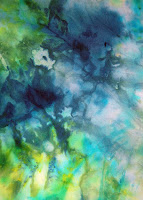If you haven’t tried rusting fabric and would like to, its really simple, very exciting and rewarding. The following is all you'll need to know to try it.
1. Spray or soak fabric with a solution of 50% water and 50% white vinegar.
2. Spread the wet fabric in a plastic container like a dishpan or storage bin and arrange rusting objects
on top of it or wrap the wet fabric around a rusty object and lay it in the plastic container
3.Then wait it usually takes only a day or two but you need to keep the fabric wet with the vinegar and
water. Some people like to cover it all with plastic to keep it wet, but remember that you want to let in
air because oxygen it what causes oxidation (rusting) so wrap it loosely if you do.
4. When you have the amount of color you want, rinse with a solution of water and baking soda to neutralize the
acid before washing, there by inhibiting the process.
And that’s all there is to it But there are a couple important things to keep in mind:
A. Just because rust is so familiar and generally not considered toxic, this does not mean you should ignore
safe studio practices. Rust is iron oxide which could harm your health if you have to much contact
with it. So it is advisable to wear your gloves and mask if you plan on doing this often And be sure keep young children and pets away from the rusty liquid!
B. Rusted fabrics will eventually degrade (although it may take years) because oxidation continues as
long as it is exposed to oxygen. Therefore, rusted fabric may not be the best choice for a quilt that you
are planning to hand down to you grandchildren. If you would like more information about the process, I found Kimberly Bater Packwood’s Blog
http://www.prairiefibers.com/Rust%20Dyeing.htm is very informative and helpful. Also, she has some very affordable and informative ebooks on natural dying as well as on line classes available @ http://prairiefibers.com/
The "before" of the illustration at the top of the page. Vinegar and water soaked silk wrap around an old rusted cast iron window weight,












